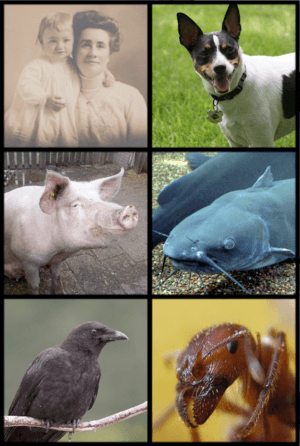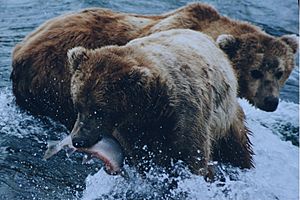Omnivore facts for kids


An omnivore is an animal that can eat and live on both plants and animals. Omnivores get their energy and nutrients from both plant and animal foods. They can digest things like carbohydrates, proteins, and fats from these sources. Sometimes, they can even eat things like algae, fungi, and bacteria.
Animals became omnivores in many different ways. For example, dogs came from animals that mostly ate meat. But pigs came from animals that mostly ate plants. Even so, how an animal's teeth look can often tell us what it eats.
There are many kinds of omnivores. They can be grouped by what they prefer to eat.
- Frugivores mostly eat fruit. Examples include maned wolves and orangutans.
- Insectivores mostly eat insects. Examples include swallows and pink fairy armadillos.
- Granivores mostly eat seeds. Examples include large ground finches and mice.
Being an omnivore helps animals find food more easily. This is especially true when food is scarce or in places where food sources change a lot.
Contents
What Does "Omnivore" Mean?
The word omnivore comes from two Latin words. Omnis means 'all', and vorare means 'to eat'. So, an omnivore is an animal that eats 'all' kinds of food. This word was first used in the 1800s.
Scientists use two main ways to define an omnivore:
- Behavioral: This means an animal is actively eating both plant and animal materials. For example, if a person eats both vegetables and meat, they are behaving like an omnivore.
- Physiological: This means an animal's body is able to get energy and nutrients from both plant and animal matter. For example, humans are physiological omnivores. Our bodies can use nutrients from both plants and animals.
It's important to know the difference. A chameleon that eats leaves and insects is an omnivore. But it is very different from a pig that digs for roots and eats leftover meat.
Different Kinds of Eaters
There isn't a special group just for omnivores in animal classification. This is because omnivores are found in many different animal groups. For example, the group called Carnivora includes many meat-eating animals. But not all animals in this group are strict meat-eaters. And not all meat-eaters are in this group.
Sometimes, animals that are usually meat-eaters (carnivores) will eat plants. And animals that are usually plant-eaters (herbivores) will eat animal parts.
- For example, cats sometimes eat grass. They do this to help them throw up things they can't digest, like hair.
- Animals like giraffes and camels might chew on bones. They do this to get important minerals and nutrients.
- In 2013, scientists found that American alligators sometimes eat fruit. They might do this on purpose or by accident.
These actions don't always make them true omnivores. For an animal to be a physiological omnivore, its body must be able to get energy and nutrients from both plants and animals.
Some animals are called "life-history omnivores." This means their diet changes during their lives.
- For example, young geese might eat mostly animal tissue. But as they grow up, they eat more plants.
- Many mosquito species eat plants and nectar when they are young. But adult females also drink blood to lay eggs.
Examples of Omnivores
Omnivorous Mammals
Many different mammals are omnivores in the wild. These include:
Most types of bears are omnivores. But what they eat can change a lot. It depends on what food is available where they live. For example, a Polar bear mostly eats meat. But other bears might eat more plants.
Wolves, dogs, and coyotes eat some plant matter. But they are mostly meat-eaters. However, the maned wolf is a type of dog whose diet is naturally half plants.
Squirrels mostly eat nuts and seeds. But like almost all mammals, squirrels will eat animal food if they find it. For example, the eastern gray squirrel sometimes eats bird eggs and baby birds.
Other Omnivorous Species
Many birds are omnivores. Their diets can include berries, nectar, insects, worms, fish, and small rodents. Examples include:
Some lizards, turtles, and fish are also omnivores. Examples include piranhas and catfish. Many invertebrates (animals without backbones) are also omnivores.
Even animals that are mostly plant-eaters will sometimes eat small amounts of animal food. For example, sparrows are mostly plant-eating birds. But they often feed their chicks insects. This helps the chicks grow strong. Also, monkeys often eat fruit that has maggots in it. They sometimes even prefer it to perfect fruit!
See also
 In Spanish: Omnívoro para niños
In Spanish: Omnívoro para niños


